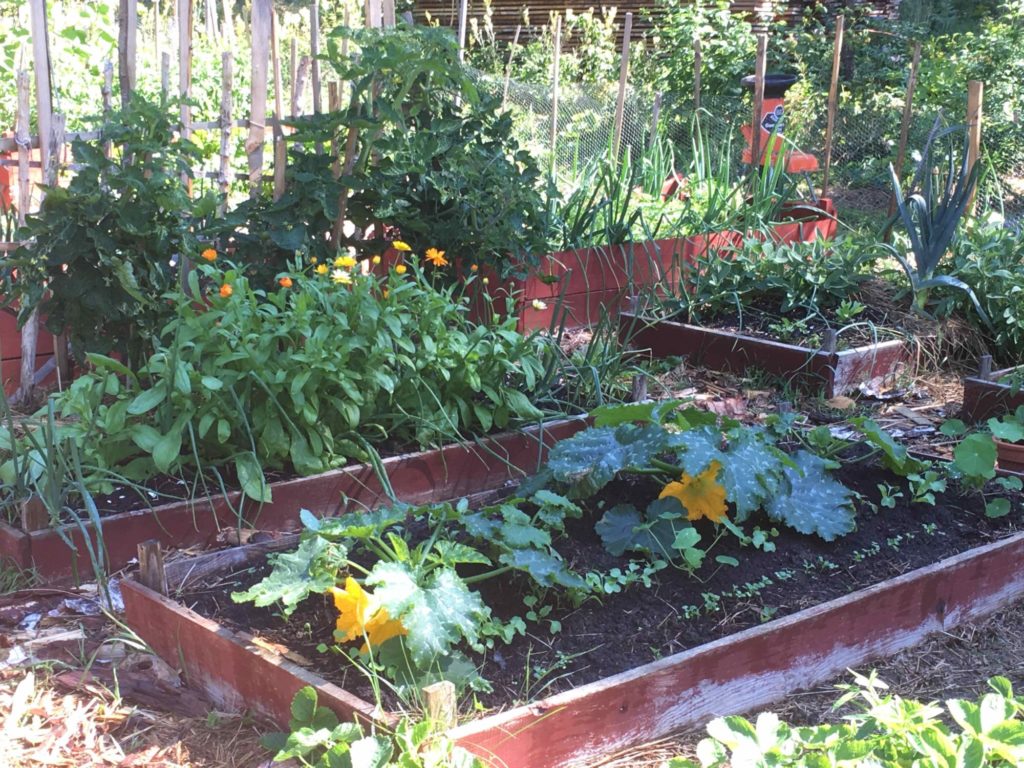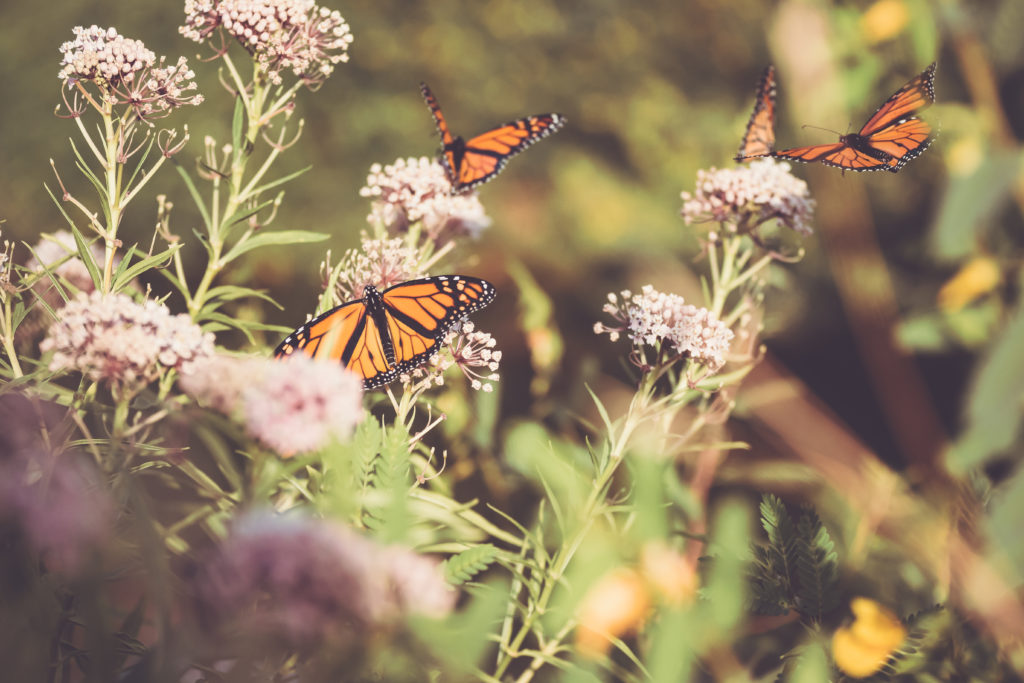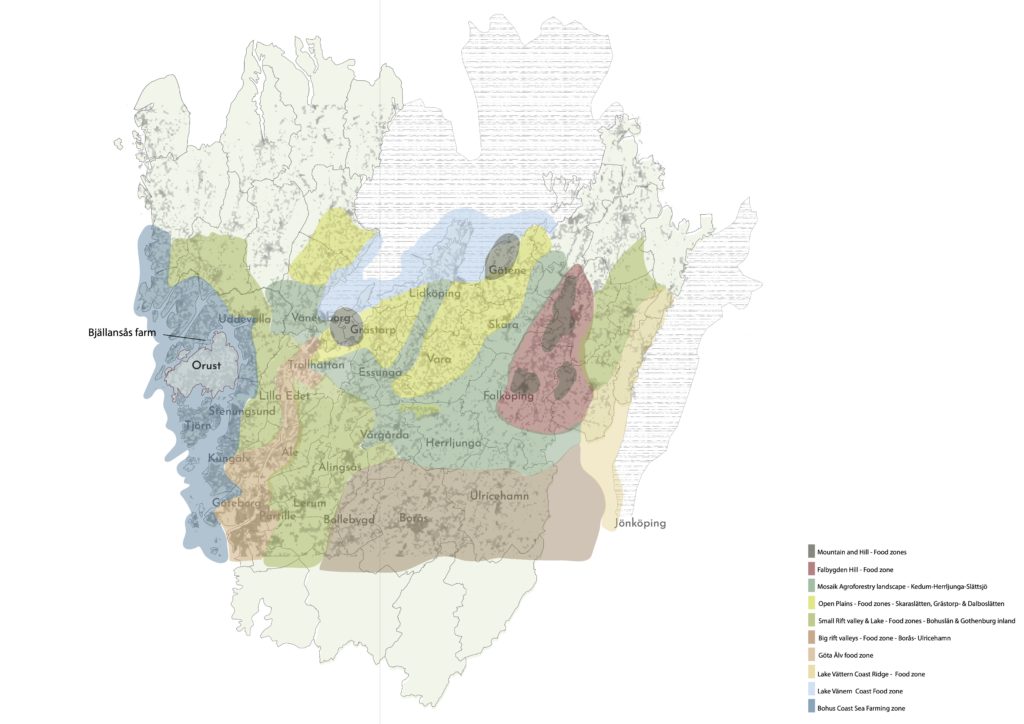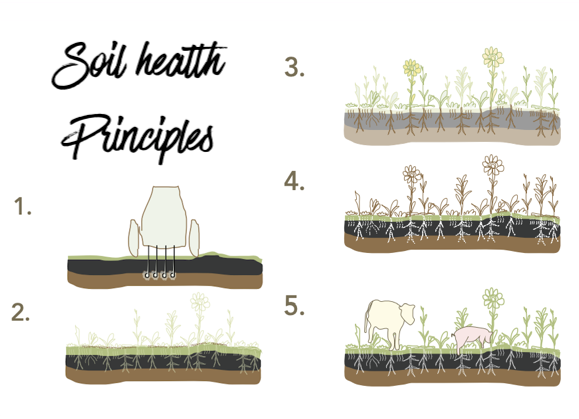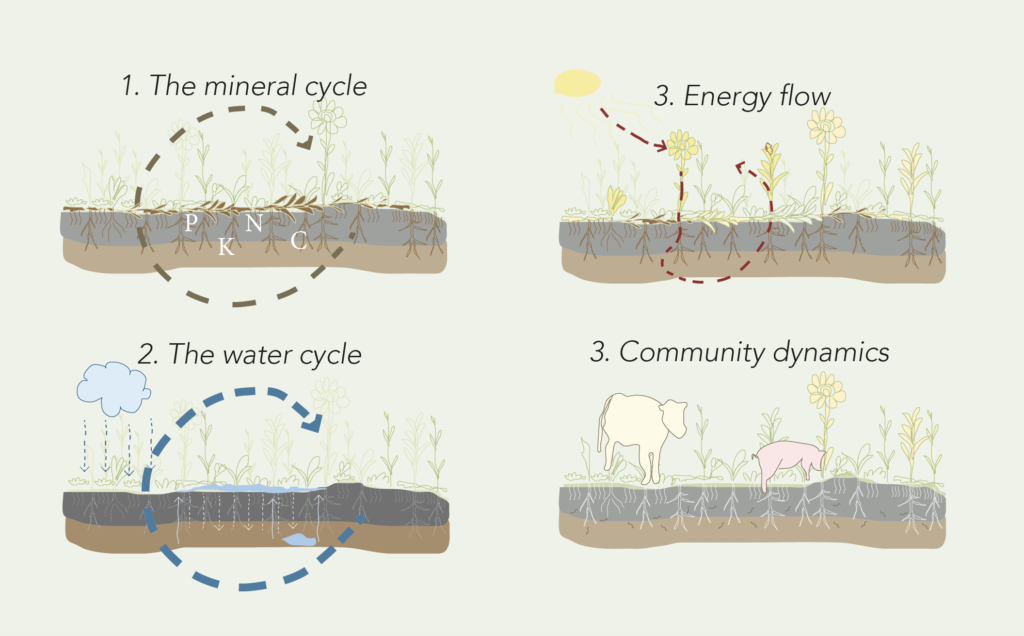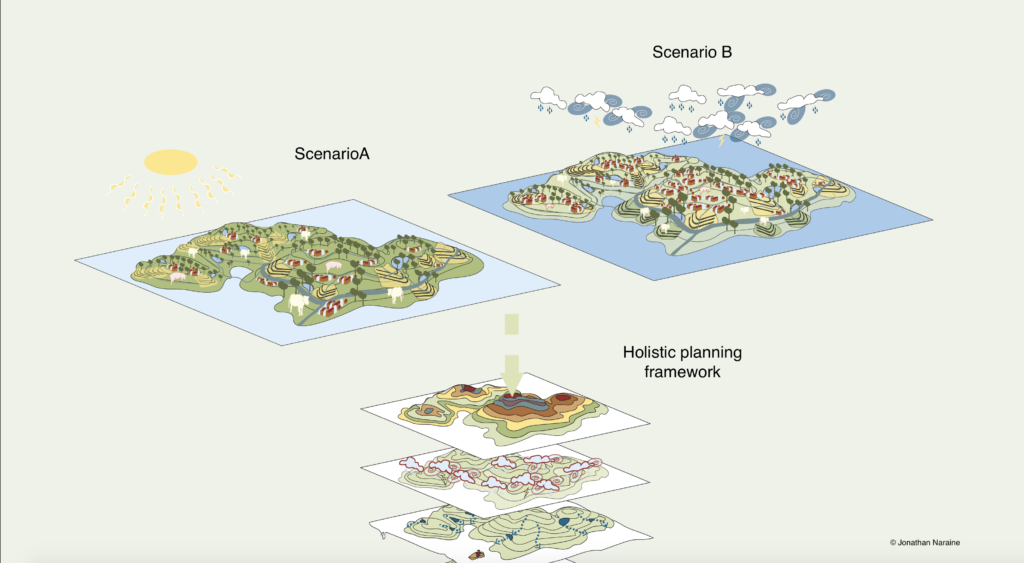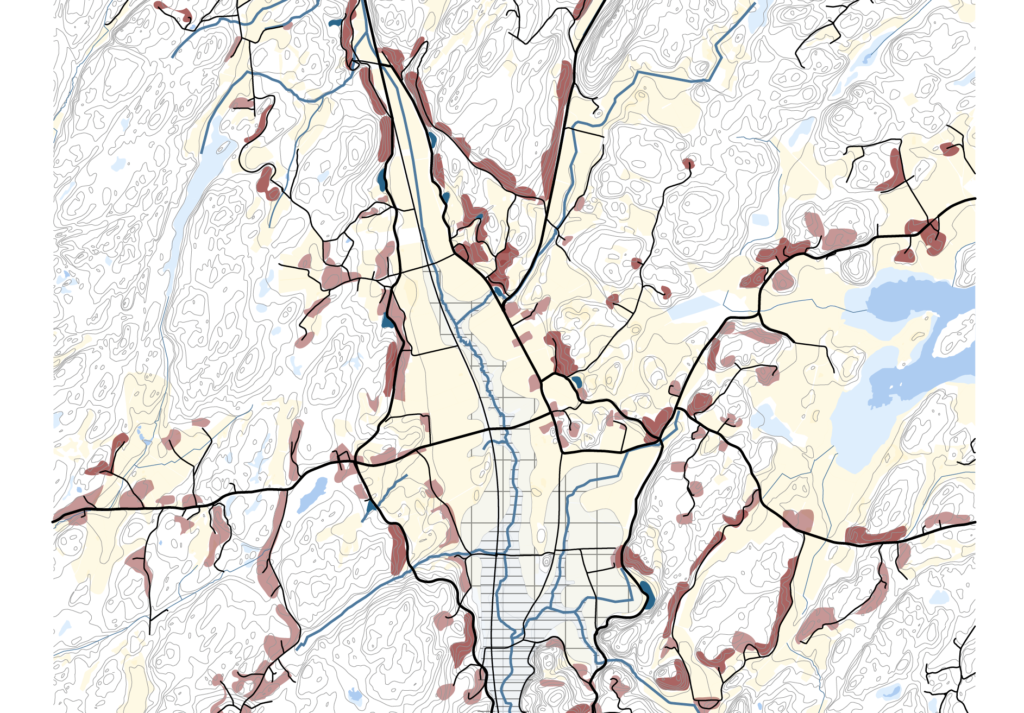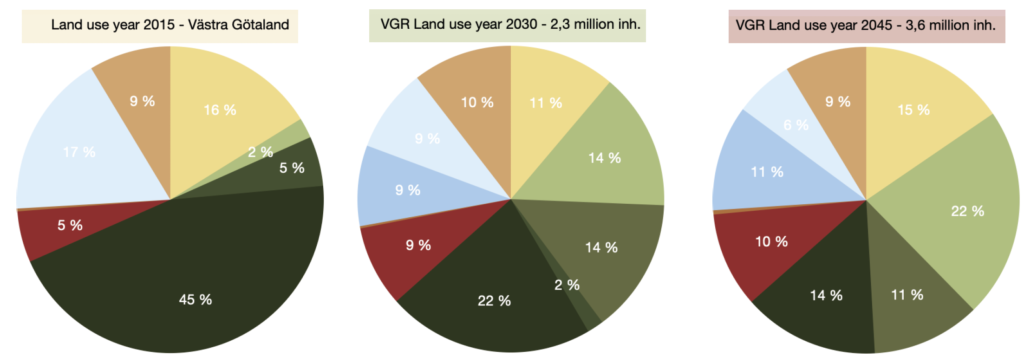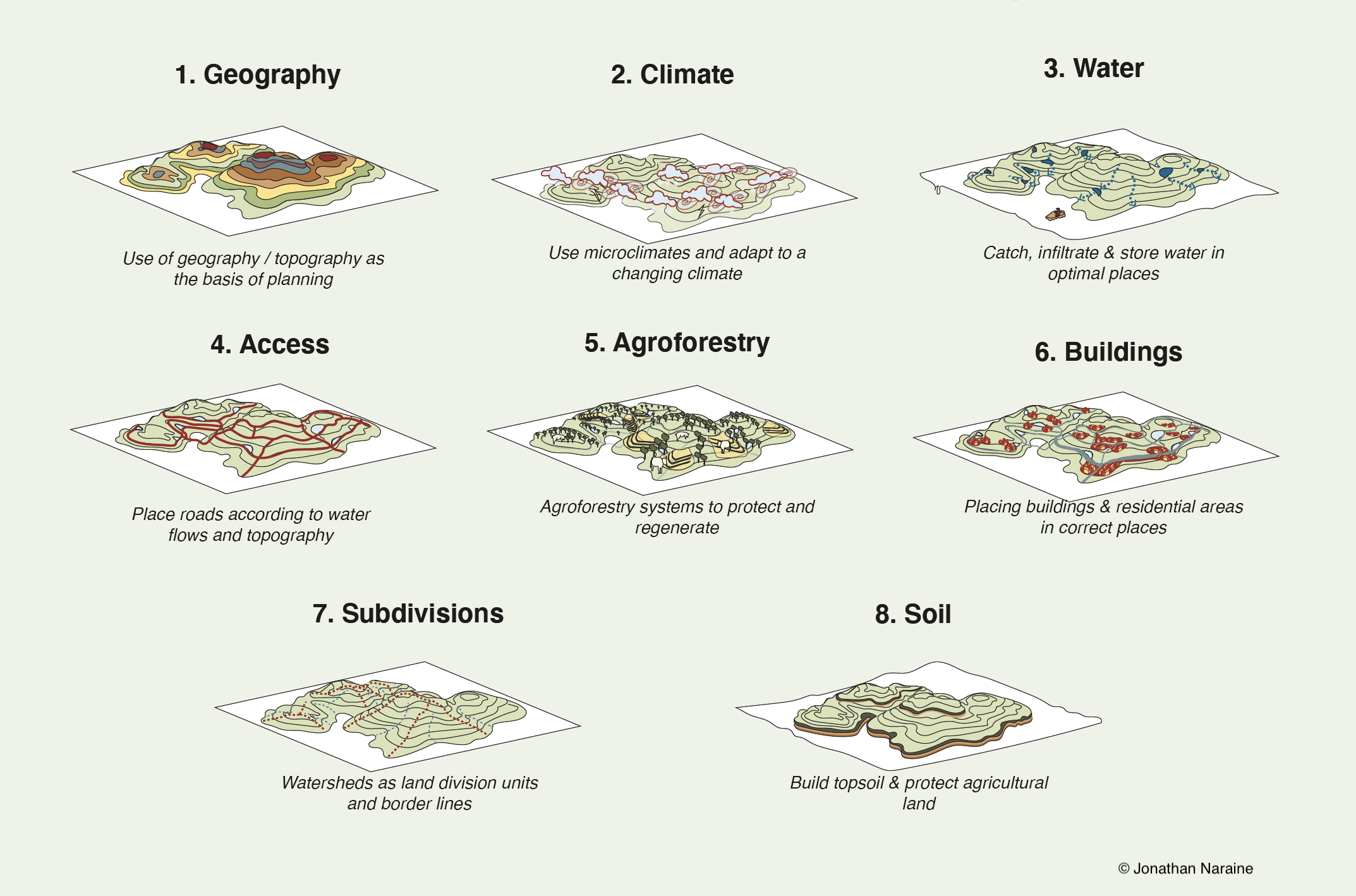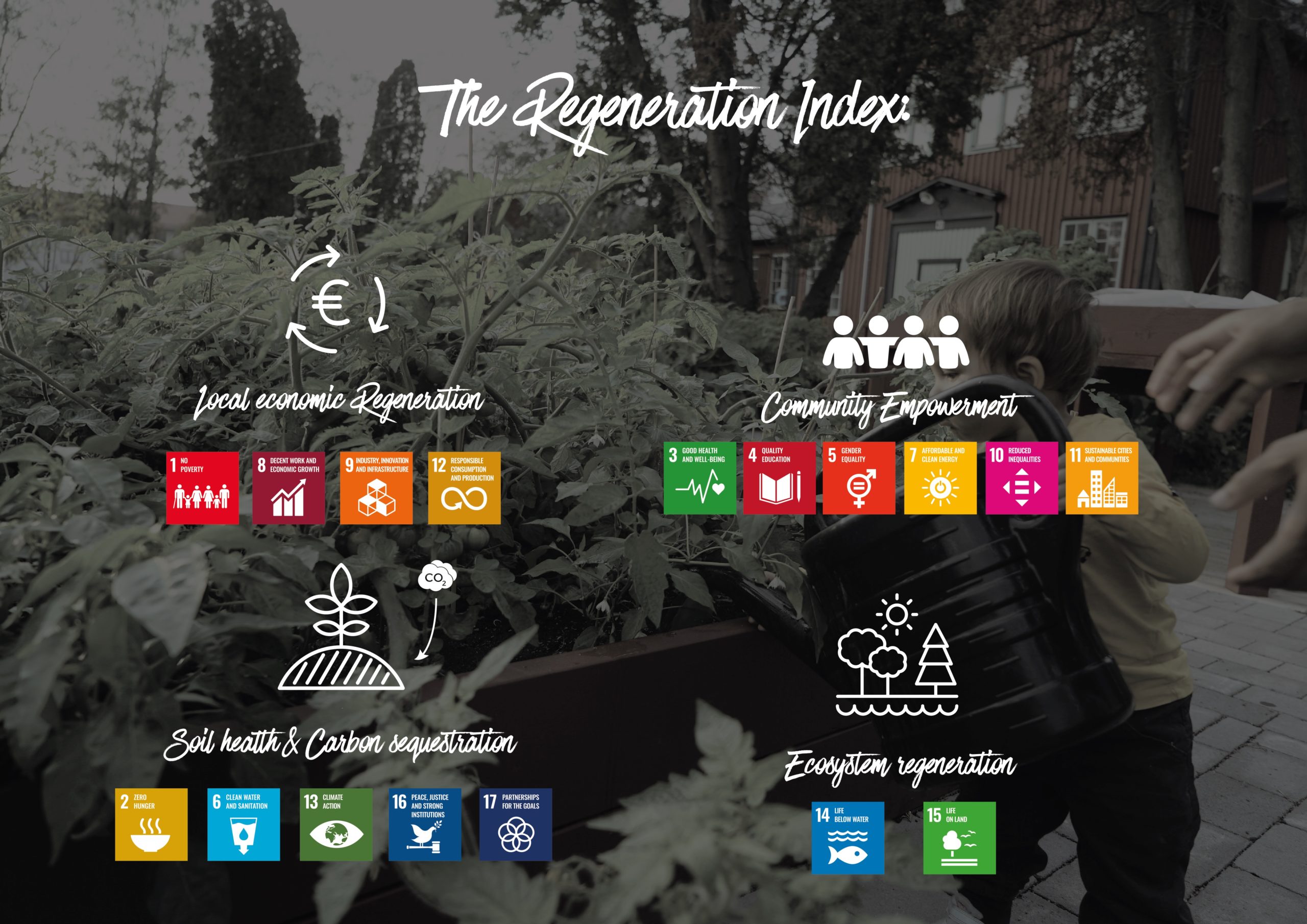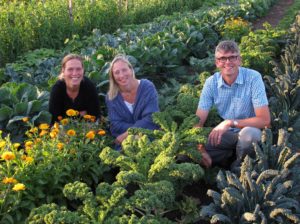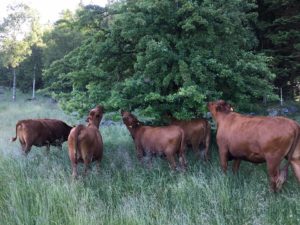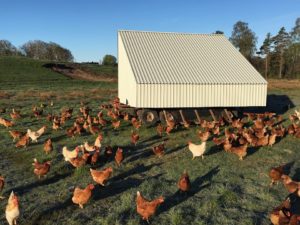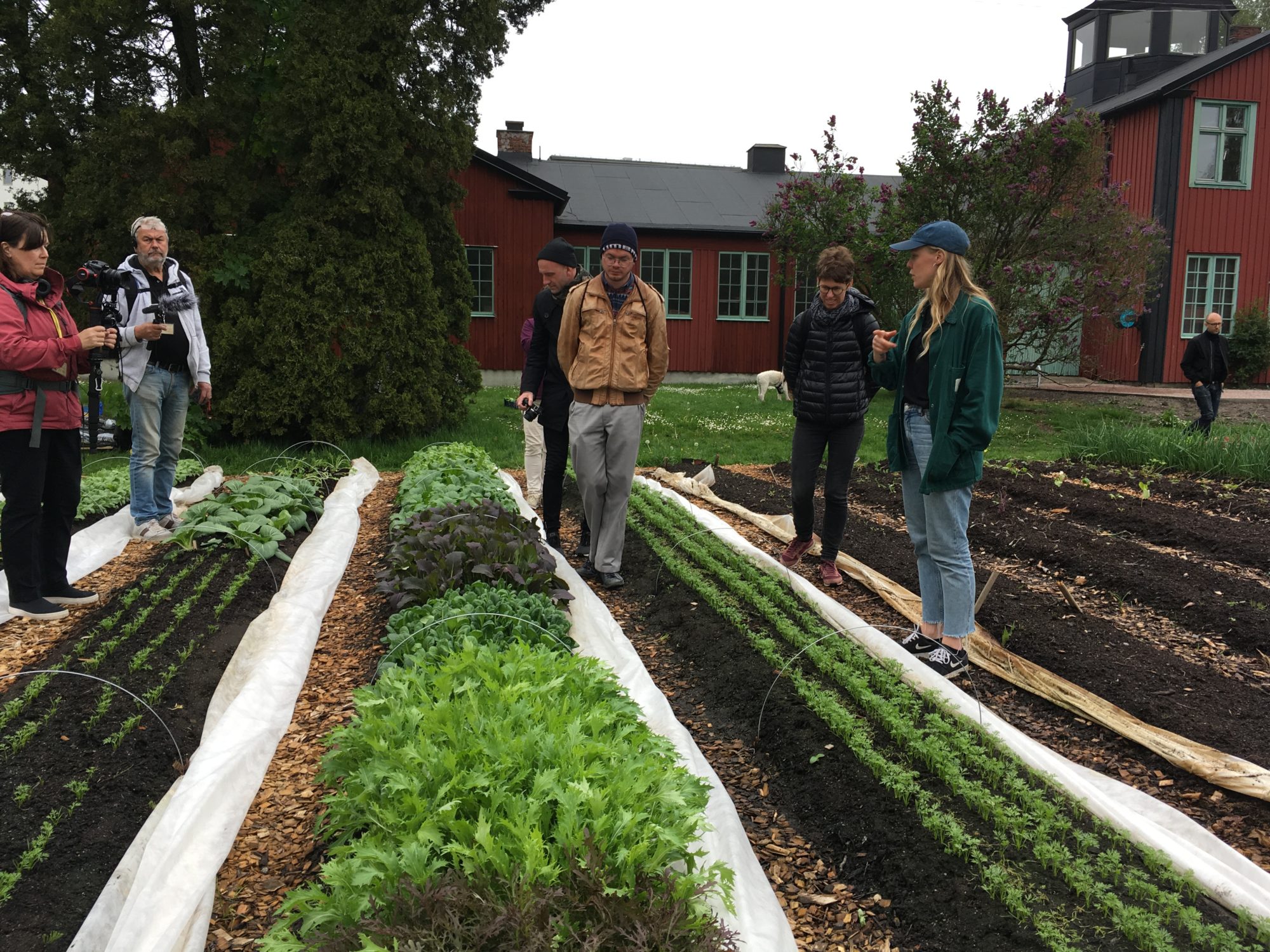
Your garden matters – for biodiversity and climate adaptation
Today, May 22, is Biodiversity Day. So to celebrate the day today we thought we’d talk about how you and I can create our own diversity gardens that also combat climate change and make us more resilient to the extreme weather we’ll be expecting in say 50 years. How can we adapt our cities, villages and communities to a changing climate? Imagine it’s May 2073 and it’s been 30 degrees now and drought for weeks, not a drop of rain. However, some cities have adapted but not all. What does this future city and countryside look like? And what can we expect with 3-4 degrees higher temperatures on average in Sweden – maybe even higher if we don’t manage to keep global warming below 2 degrees? In this blog post, Jonathan tells what he takes away from the basic course and gives 5 solid tips on how you can cultivate for increased biodiversity. How to build a climate-smart diversity garden simply!
(The picture above is from a Urban Farming Safari we arranged on Biodiversity Day a couple of years ago)
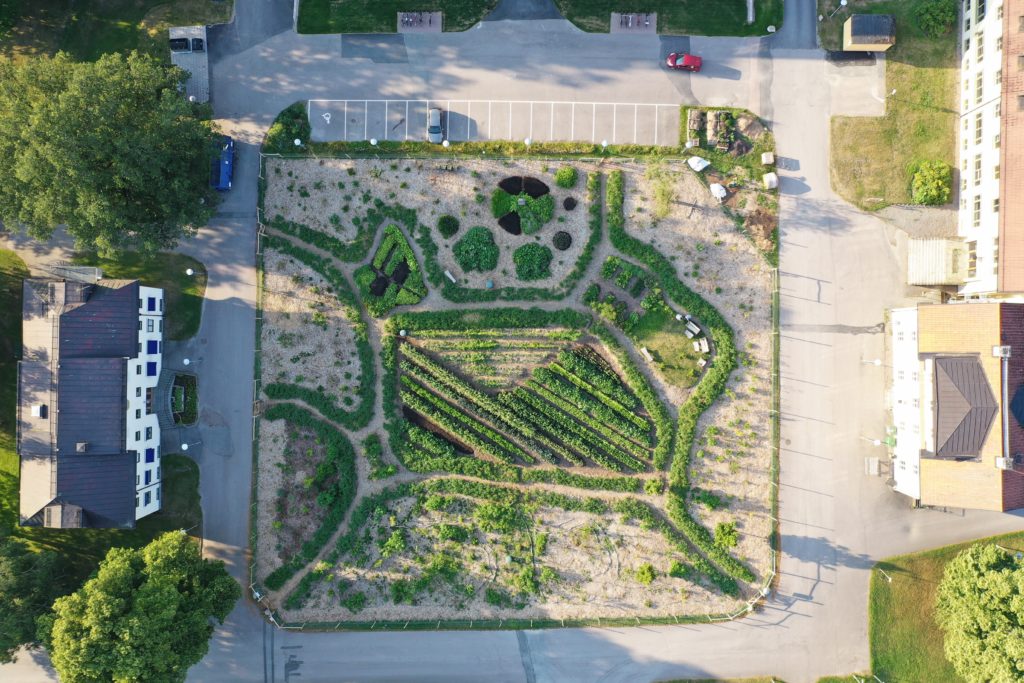
Ultuna’s food park – picture from Ultuna Pemakultur on their cultivation at the SLU Campus in Ultuna – A good example of a climate-smart diversity garden where many of the tips we share below have been used as a starting point. Read more here
Climate change and biodiversity
Did you know that we in Sweden can count on 3-4 degrees higher temperatures on average – even if global warming is limited to 2 degrees? What does this mean and what can we do? Jonathan was recently on SMHI’s basic course on climate adaptation and there the message was clear. More greenery and “nature-based solutions” – such as cultivation, green roofs and carbon storage in agricultural land are all ways to both counteract the loss of biodiversity and adapt to a changing climate with extreme rains and droughts, heat waves, etc. The fact is that biodiversity and climate adaptation are very much connected – both in terms of the challenges and the solutions. And your cultivation, whether you cultivate in the city or in the countryside, is an important part of the solution for increased biodiversity and resistance to heat, drought and torrential rain – yes, even a carbon sink that can prevent climate change.

Slaktarens trädgård – The butcher’s garden – a farm on the former asphalt “dessert” close to Gamlestads torg (in central Gothenburg) that adds both biological diversity and increased climate adaptation with better management of rain, drought and heat in the city.. Read more here.
Three things I take with me from the course in Climate adaption
- Sweden’s climate will be much warmer than the global climate (if the global temperature increases by 2 degrees, it increases by 3 degrees or in some areas even 4 degrees in the northernmost part of Sweden)
- Climate adaptation and climate mitigation (adapting to and preventing climate change) must go hand in hand. It is not enough to just reduce emissions, if we stop emitting tomorrow, we need to continue adapting society to a warmer climate for the next hundred years. This adaptation takes time so we need to start now.
- The solutions that are most cost-effective are natural solutions such as greenery and nature-based solutions that fulfill many functions. It will not help to build walls around cities that are at risk of flooding, these will have to be replaced in time and the city may still have to be moved in the end.
Biodiversity day – 22 Maj
Let’s celebrate all gardens!
A lot of research has shown that gardens in and around cities and urban areas contribute a lot to higher biodiversity. A lawn and “ordinary park” comparatively does not have as much diversity as a garden plot or plot with flowers, trees, shrubs and crops. In addition, a vegetable farm or forest horticulture can create a net carbon sequestration if done correctly. Something that both strengthens life and diversity in the earth, and also contributes to slowing climate change at the same time as we adapt to a climate with more drought and torrential rain. More carbon in the soil means more humus which holds more water in both dry and wet periods and thus reduces the risk of flooding and drought (which are often linked and due to poor marine filtration and absorption in the soil). Building soil, loamy soil, is thus an important part of the solution to how we adapt our societies to a warmer climate – and we get higher diversity and carbon storage at the same time. Personally, I would like to see a shift to regenerative agriculture on large areas in Sweden, but apart from this, even the small patch has a great significance.
[Abbreviated quote from Swedish gardening profile John Taylor during the spring in an interview on SVT’s program Sverige (April 14).]“Gardening as a social engine in society is gigantic. There are millions of people who garden and yet it is considered a small hobby. We are responsible for food production, landscape care and a greater part of the biological diversity in society”
How to build a “climate smart” biodiversity garden:
Here are 5 tips from Jonathan – architect and community planner with specialization in cultivation and food production,
- Start digging where you stand:
Do you own a piece of land? Think about what you want with the surface. Perhaps you can invite more people to create your or someone else’s dream garden. Share farmable land on Grow Here if you want to find growers to take care of all or part of the garden or list an existing farm or garden if you are looking for someone who can help and be part of your garden dream or your cultivation initiative.
If you don’t own a piece of land/garden… Search among available cultivation areas and cultivations on Grow-Here.com/discover or ask the neighbor or the municipality, the BRF or those who take care of the green areas near you where you would like to grow. You don’t have to own the land to farm here, often the owners are happy if it is put to better use and can also have higher diversity, aesthetic values and withstand extreme weather better.
- Cultivate the soil, then the plants also thrive
It all starts with a healthy soil with a lot of soil (humus) which consists of 50% carbon, which can hold 20 times its weight in water and thus makes your garden able to withstand both drought and extreme rain. In addition, the humus content increases the food for all life in the soil, which provides food for all plants – which provides food for us. So build a healthy and humus-rich top soil and the plants will thrive in return. Regardless of whether you have sandy or clay soil, it will be “better” with more organic matter (mulch).
You can read more about how to convert grass into cultivation without digging here
- Grow the things you eat, things you enjoy – and what likes to grow there
– Grow what you eat – which vegetables, herbs, berries/fruits and perhaps perennials you don’t have to sow every year.
– Flowers you like to pick that can attract beneficial animals and look beautiful.
– Shrubs and trees that can provide fruit, flowers and both food/habitat for wild animals/insects.
– Co-planting: Dare to mix and combine edible and beautiful, and take advantage of the benefits of co-planting. More on that in this premium article. - Cultivate smart: Serial cultivation, pre-cultivation
– Serial gardening means that you use all free surfaces in time and space and pre-cultivate what you intended to plant so that it is ready just in time for the surface to become empty. A good tip is to make a cultivation plan to know what you need and when to fill all the gaps in the cultivation over the season.
More on that in our premium article on how to become self-sufficient in vegetables.– Pre-cultivate if you grow edible annual crops – get tips on when you grow what in our growing calendar for April and May.
You can also read more about cultivation in our previous blog post about cultivation indoors and outdoors. - Last but not least – Enjoy and dare to be lazy!
– Dare to be a lazy worm in the garden and don’t create more work for yourself than necessary. Lay down in the hammock or on the lawn and take in everything that happens. Notice how clever nature is at solving things you yourself thought you needed to solve.
– Enjoy observing what works well in which places and invest in what you get the most out of around what means something to you. Maybe it’s food, maybe a beautiful place, maybe just a chore that relaxes you.We have made a series of videos where we share more cultivation tips in brief with a small challenge you can try yourself. Here you can e.g. learn more about pre-cultivation, solar studies for vegetable garden placement, green fertilization, interplanting and much more. See the playlist on youtube and the first video via the link below:
I wish you all a nice spring and summer in the unusual May heat and good luck with your farming and gardening dreams and goals for this season!
Sunny greetings,
Jonathan Naraine
Architect, grower and food system designer
Co-founder, Grow Here platform
Planning architect, Skara municipality

Carbon positive food regions & Food system design – Part 2
Can a region sequester more carbon in the soil than is emitted by all consumption of its inhabitants? What can cities, regions and governments do to design carbon positive food regions? Why is it important to support regenerative agriculture and build more local resilient food systems? What are the 6 regenerative planning principles? How will these regenerative food systems look like 5-10 years from now? What larger social, environmental impacts can be expected and what is need to get here? In this article Jonathan shares the key take aways and planning strategies from his master’s thesis “Carbon positive food regions” published at Chalmers University of Technology in June 2022.
Carbon positive food regions – Key take aways
This spring Jonathan has been finishing his Master Thesis in Architecture and Planning on the topic of Food System Design and how we can co-create “Carbon positive food regions”, which is also the title of his thesis. Below you will find some of the key takeaways from the thesis work with tips on how architects, planners and designers can create more local and regenerative food systems.
Can a region sequester more carbon in the soil than is emitted by all consumption of its inhabitants?
This question we asked in part 1 of this blog series Co-designing Carbon Positive Food Regions – Part 1. In this first blog article on the theme Jonathan introduced the ideas behind his master thesis during the spring. But now let’s explore the results and final take aways from the thesis. Below you’ll find the interview where international blog “Agritecture” interviewed Jonathan this August. Previously this spring Agritecture also wrote a blogpost about the Grow Here platform and our work with creating more local food systems, read it here.
Let’s dive into the interview!
1. How do you define “carbon-positive food regions?
Well this is a very interesting question indeed. In my Master’s thesis I define both Carbon Positive and Food regions or Food systems to give a greater understanding of what this means. Let’s start with “Food regions” of “Regional food systems”, what does that actually mean…? Well, many regions struggle with defining what is “local food”. How many food miles can we allow for the food to be considered local? Perhaps it is all about having a close relation to the food and I personally believe ”food regions” and ”local food” can be defined in different scales by setting some boundaries such as distance, relationship with the farmer etc.
I have taken inspiration from how Trafikverket (2015) identifies the main types of geological land conditions in the region of Västra Götaland. These very much influence our ability to grow different types of food here and I personally use them as a basis for defining larger food regions. I believe these geological regions will likely specialize in certain foods. F.ex. ocean farming in the case of “Bohus coast”, field crop farming in the case of the “Open plains” of Skara, Grästorp and Dalboslätten and the Mosaik landscape will likely have more grazing animals. See the illustration below where the different potential food regions of Västra Götaland are visualized:
– What types of agricultural practices does this term embody (e.g. regenerative farming)?
Regenerative agriculture is one of the most exciting topics of our time. In short it is a way of farming where the outcome goes beyond being just “sustainable” (meaning doing less bad) to actually having a truly positive and “regenerative” impact on ecosystems, social systems and local economies. Regenerative agriculture is not really a method of farming like organic where you avoid chemicals, etc. Even if it is usually described as such the key to defining it lies in the meaning of regenerating. Regenerative agriculture is more of an outcome towards regeneration of soil, ecosystems and communities. However there are some principles and frameworks we can use to better understand how to get here. Let’s dive into these.
First let’s have a look at soil health – the basis of life in so many ecosystems!
5 principles of soil health:
- Limited disturbance:
Reduce tilling as it disturbs soil structures, resulting in soil erosion. Chemical pesticides and fertilizers also disturb the soil. - Armor:
Nature always works to cover the soil and protects it from wind and water erosion. F.ex. dead organic matter breaking down or living cover crops creates this armor on the soil. - Diversity:
Avoid monocultures and strive for diversity. Integrate many species of plants with varying root depths and niches as it feeds a variety of microbes in the soil. - Living roots:
Maintain a living root in the soil as long as possible. Green growing plants means living roots, feeding soil biology by providing its basic food source – carbon. - Integrating livestock:
Grazing animals stimulates plants to pump more carbon into the soil. This drives nutrient cycling by feeding biology. It’s also important to provide habitat for all fauna, birds, insects and microbiology.
(Brown, 2018. 2min 30)
Soil – the foundation of life
Using these principles means we try to build soil and nurture the microbes in the soil. And soil carbon is deeply linked with soil microbes. The great numbers and diversity of microbes in the soil, the more carbon and humus can be stored, and the more water infiltrated. This has many benefits for both climate change mitigation and adaption as well as increasing biodiversity in soil and above soil. Soil life is the foundation of all life on land according to farmer Gabe Brown (Qwiberg, 2017, Brown, 2018). In fact both you and I are made up of microbes that originate from living soil. Did you know that 90% of our DNA is actually not human DNA but that of our microbiome living within us. Many thus believe human health to also be connected to the health of the soil.
Soil health, plant health, animal health, human health, planet health – all interlinked through soil carbon.
Illustration of the 4 ecosystem processes – ©Jonathan Naraine
The ecosystem processes
So how do we ensure soil is regenerated and not lost, how do we know ecosystems are revitalised? Four important processes govern the regenerating of land based ecosystems – these are called the Ecosystem processes. These processes all influence each other in positive or negative spirals and measure overall ecosystem vitality:
1. The mineral cycle – How well is carbon, nitrogen and other minerals being cycled, producing healthy topsoil?
2. The water cycle – How well is water captured and stored in soil to be accessed by plants?
3. Energy flow – How much energy is produced by photosyntesis and cycled for all other life?
4. Community dynamics – How well are the synergetic relationships thriving of the biological communities in the ecosystem?
(Savory Institute, 2020)
Bjällansås farm design explorations – ©Jonathan Naraine
2. Why should cities and governments dedicate resources to creating “carbon-positive food regions”?
How we act in the next 10 years impacts the coming hundreds/thousands of years. It’s not enough to decrease emissions, we need to start sequestering carbon on a global scale, Paul Hawken claims. (Tickel, 2020)
In order to answer this question we must first consider where we are at as a society, with planet earth and the human race heading towards the cliff. The planet will be fine but the human race and many other species along with it might very well go extinct in this process. The reasons? Well you all know them well by now.. There are many planetary boundaries we are now exceeding according to climate scientist Johan Rockström (2015). The most urgent ones are perhaps climate change and exponential biodiversity loss (the 6th mass excinction) but also the Nitrogen and Phosphourous cycles that are way out of balance. The way we farm is connected with “almost all planetary boundaries” says Rockström (2015, p.11). Agriculture and land use is thus the biggest contributor and transitioning towards regenerative agriculture is the biggest potential solution to most of these challenges I argue. Let’s dive a little deeper into the seriousness of the issue to really understand why this is important.
”We’ve lost an estimated 50-80% carbon in our soils over the last 150 years”
Judith D. Schwartz (2013, 1h 39 min)
In just one generation our soil could be lost
Depleting our soils as we currently do at an alarming date (due to our “degenerative agriculture”) is likely to lead to Planet Earth running out of living topsoil in just one generation (Qwiberg, 2017) – with global famine, wars fought over food and ultimately the collapse of civilisations as we know it (P3 Dystopi, 2022). The use of pesticides like roundup is also linked to us being on track to excinction as a species within the next 70 years according to Dr. Zach Bush (Kempf, 2020, 18 min). But as fast as we degrade soil we can also build new topsoil according to regenerative farmers around the world that I have studied in my thesis for inspiration on both design and management of these type of farm landscapes.
”If we basically degrade half of our abilty to feed the planet and increase numbers (population) with another third there won’t be enough food to go around. […] And that’s a recipee for societal collapse.”
David Montgomery (P3 Dystopi, 2022, 42 min) Professor of Geology at Washington University
3. How has your Master’s thesis investigated the means through which we can go about creating these ”carbon-positive food regions”?
How do we design these Carbon positive food regions then?
Yes! Let’s jump straight to the conclusion!
I asked the question in my thesis – Carbon positive food regions, is it possible? The answer became yes! And so how do we go about creating them?
In my thesis I did a few “design explorations” combining the methods and tools of Holistic management, Keyline design & Permaculture design into what I call a “holistic planning framework”. By exploring two future scenarios of a carbon positive region, self reliant on food – the lessons from the design explorations on Bjällansås farm and Orust municipality were used to formulate “regenerative planning strategies” for physical planning.
Food system design explorations
I made design proposals for the farm to produce more food and regenerate more topsoil by incorporating more animals and also trees and vegetable crops. I created the basis of a strategy of food self reliance at the municipality and island of Orust (Swedens fourth biggest island). See their context in the region on the regional food illustration at the top (above is also a case study looking at one of the rural nodes). Finally I also did some calculations of Västra Götaland Country (our administrative region on the west coast of Sweden) to see if we could be self reliant and carbon positive as a region.
Västra Götaland can be self reliant and carbon positive!
It turned out Västra Götaland County (VGR) can become carbon positive and feed ourselves even with an increase in population with 50%, if we really make bold visions and start planning our future food system in regards to population growth. Below you can see the estimations of land use needed where we need to go from 16% crop fields fo farming and 2% gazing area to about 50% of our land being devoted to mixed small scale diverse regenerative agriculture.. Thus I concluded that the 45% monoculture forest that is currently in the area needs to be reduced to 14% in order to house this farmland.
The farmland entails semi open agroforestry based crop fields (yellow), grazing areas (light green) and forest integrated farming with goats and pigs renewing the forest ecosystems and the built area cannot more than double even if population doubles. So we need to avoid urban sprawl and plan our cities wisely to not build on agriculture land.
My design work followed a method of backcasting and I used design tools used in regenerative farm design and incorporated food system design tools such as calculating the land and water area needed to grow our food and its potential carbon sequestration. The result? Well, it became a methodology in itself which can be very useful for planners and food system designers to use at this scale.
But we are all food system designers as we are all eaters. More on that later…
What are the needs of “Food system design”?
To say that food system design is needed in this century is an understatement. I believe it is one of the most crucial disciplines of this decade as the way we shape our food system and its ability to combat climate change, biodiversity loss and global soil erosion and adapt to more extreme climate. The primary result from my design research on Food System Design at three scales – (1) the farm, (2) the municipality/city and (3) the region/county – is actually more of a general methodology and principles for planners to apply. I believe the actual designs can also inspire some applications but the greatest value lies in in adoption in scale by municipal and regional food system planners. Below is the 6 principles outlining the design method and planning framework I have developed.
Six physical planning strategies for regional and municipal comprehensive planning;
- A decision making framework that includes future generations,
- Eight holistic land use planning principles & design layers,
- Farmland protection & food system planning,
- Monitoring & improving ecosystem processes,
- Food nodes for sales & distribution and
- Funding and co-learning around regeneration.
We will dive further into these principles in the next part of this blog series!
Below you can see the eight holistic land use principles that Jonathan developed.
Illustration of the 8 holistic planning principles and design layers – ©Jonathan Naraine
What conclusions did you draw – on what needs to be done?
The discussion of my thesis explores how bottom-up and top-down actors can meet in co-creating these local regenerative food systems and potential conflicts around water and land use. My conclusions are that carbon positive food regions are possible but require ambitious targets, conscious planning and food system design with shifts to a more multifunctional mosaik landscape characterized by agroforestry, involving a multiplicity of stakeholders in the process. The designer and architect has a central role in bridging the gap between different generations, interests and scales. So I argue we need food system design and the role of a “food system designer” requires the knowledge in design thinking in order to connect the dots between the time dimensions (considering both future and present generations), space dimensions (connecting urban and rural, small and big scale) and inviting all stakeholders around the same table (all different disciplines and actors involved in the food system need to be involved in the process).
To be continued…
In the next blog post we explore the planning principles more in depth and also some of the design explorations and what a carbon positive food system actually might look like 5 to 10 years from now. With 4 additional interview questions we also explore the role of you and me as eaters and what we can do to design our future food systems. How does our choices impact the food system design?
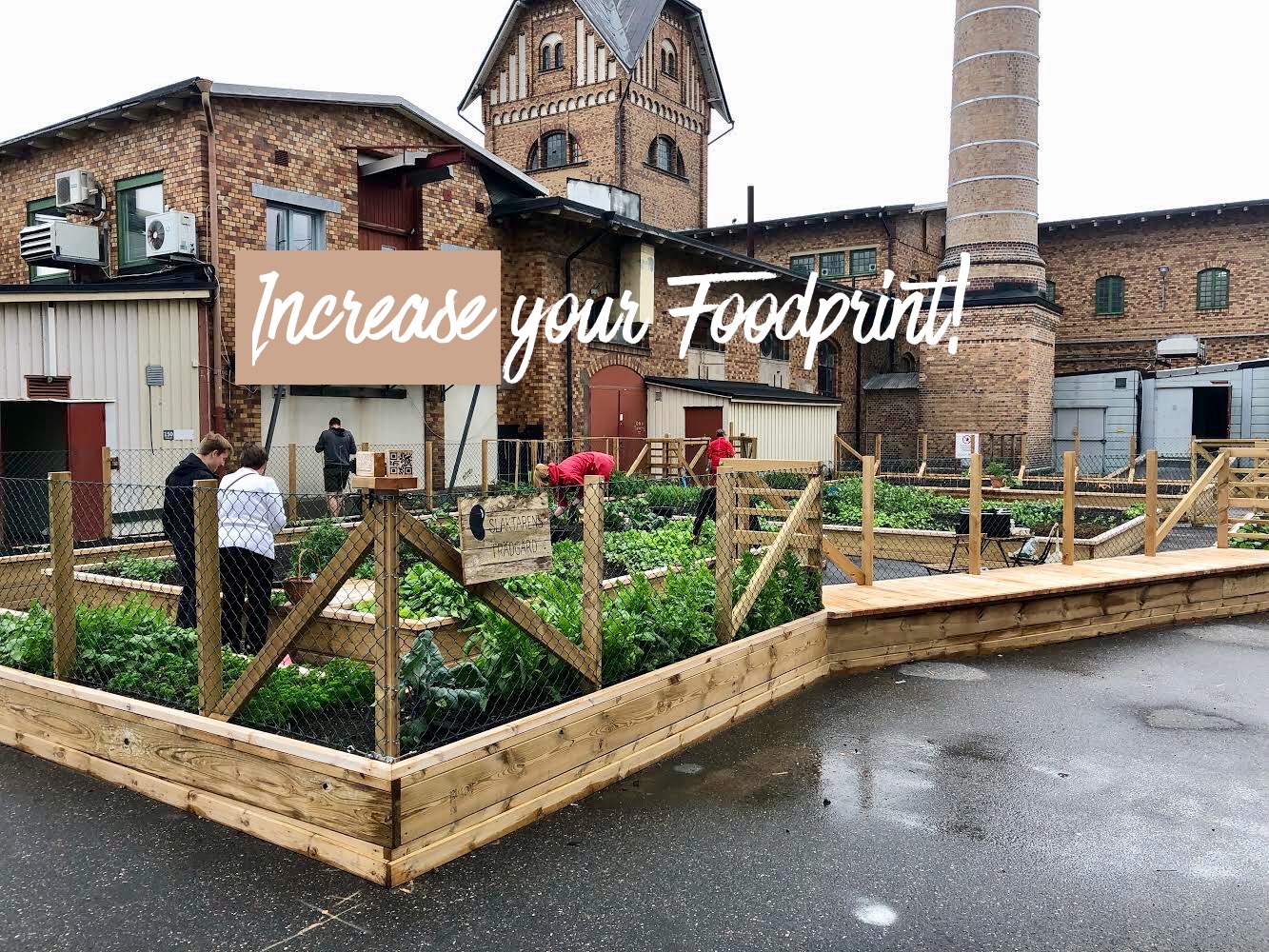
Carbon positive food regions: Part 1 – Co-creating our future
Välkomna till en spännande resa mot en regenerativ framtid! I detta blogginlägg utforskar vi möjligheten att skapa kolinlagrande matregioner, där regenerativt jordbruk kan vara svaret på en rad akuta hållbarhetsutmaningar. Vi diskuterar även hur vi genom medvetna val i vår kost kan forma landskapet och främja positiva avtryck genom maten vi äter. Lär dig hur verktygen Holistic management och Keyline Design kan vägleda oss. Tillsammans kan vi skapa en bättre värld för alla varelser som bor på planeten – båda nuvarande och framtida generationer!
CARBON POSITIVE FOOD REGIONS – and how we can co-create them
Could “Västra Götalandsregionen” (the administrative region of West Sweden) become the first to target regional net carbon sequestration in soil by supporting regenerative agriculture? Or Maybe Orust Municipality, where I do a case study in my thesis?
Regenerative agriculture could be a solution to many, if not most, of our current urgent sustainability challenges. It could regenerative our soils and ecosystems while also producing healthy food, improve biodiversity, water infiltration rates, bringing people together and creating new jobs. What if we could facilitate regenerative land use on a regional scale and thus regenerating ecosystems, communities and local economies in the region – improving quality of life for all beings? Human, non-human, present and future generations.
POSITIVE FOODPRINTS:
We design and plan our cities and regional infrastructure like roads, housing areas, water pipes etc – may we through a collaborative food system design approach also design and plan our landscapes to facilitate regenerative land use and food production? What role does physical planners have and how can we encourage bottom up initiatives led by farmers, land owners and consumers? These are some questions I explore in my Master thesis at Chalmers School of Architecture. The challenge is not not create more damage than good with tools of top down planning by finding a good balance of bottom up and top down initiatives.
The daily choices of what people eat, could itself be seen as an act of “food system design” – impacting our common landscapes for the better or for worse. By voting with our forks on regenerative land use we can create “Positive Foodprints”!
What if we could design landscapes by the very act of eating? This is what I call “Positive Foodprints”! Designing our food system can be done by making more conscious acts of eating and having a closer relation to the land and the farmer who manages it – step by step shifting the outcome of that management to land regeneration! In fact the whole design process is based on a collaborative “food system design” carried out by the daily actions of what people eat and how it shapes the landscapes around them.
DESIGNING FOOD SYSTEMS
Om min masteravhandling: Koldioxidpositiva matregioner
About my Master Thesis: Carbon positive food regions “Carbon positive food regions”, as my thesis is called, is an attempt to create a framework, method and give an example of a regenerative regional strategy – exploring opportunities of planning for regenerative agriculture with net negative emissions on regional scale – land use that also produces local food, regenerates land, ecosystems, local communities & local economies. The project is inspired by the movement of regenerative agriculture and the many stories of such farmers. In Sweden. The design research will be situated in the context of a 450 hectare farm called Bjällansås in Uddevalla – exploring its potential as a model of regenerative land use that can be scaled up regionally to build topsoil and heal ecosystems.
Follow my process
Through a series of video-blogs I will share my insights and thoughts throughout the project. The first video I recorded in Swedish is published below:
Episode 1 = Mussel farming
Did you know that 1 ton of mussels can filter 100kg of nitrogen and 10kg of phosphorus?
The first episode in a new video series where I tell about everything from aquaculture that revitalizes ecosystems in the water to regenerative agriculture that builds up food soil and revitalizes ecosystems on land. Firstly I visit a mussel farm that can filter and absorb excess nutrient in the ocean and actively reverse negative trends of eutrophication – regenerating the water ecosystems as they grow and are harvested. The video series is also an exploration of whether we can create a regenerative carbon-sequestering food system in a region or municipality, which I investigate in my master thesis in Architecture and Planning at Chalmers Technical University.
Episode 2 – Regenerative agriculture at Bjällansås farm
At Bjällansås farm Jan Karlsson have been a pioneer in organic and regenerative agriculture and on mostly rented land they are grazing 500 livestock in a way that regenerates the land. The methods of Backcasting and Scenario planning will be used – exploring two future scenarios of carbon positive regions and how they are both shaping and being shaped by the smaller scale developments of local regenerative farms like Bjällansås. The results will be a design proposal showcasing such a future from the farm scale and up to the regional scale seeing, also pinpoint key projects and strategies that actors such as the region, municipality, farmers & land owners can take to get here.
Below is part 2 in this video series where I visit the regenerativa farm Bjällansås att Bokenäset in Uddevalla kommun (video in Swedish).
More will come up (including some in English) so please follow our channel: https://www.youtube.com/c/GrowHere/
What does regenerative mean?
This is worth diving more into and during my Master program – Design and Planning Beyond Sustainable development at Chalmers – I created this Regenerative Index (which is still work in progress) to summarize for me all the dimensions that we need to include as design criteria when we plan and design. Considering its impact for all beings, current and future generations. It is not simply about soil health and carbon sequestration (or planetary health), it’s about building thriving communities and regenerating our collective human health, our local economies and the health of our water and land ecosystems. This subsumes all of the Agenda 2030 SDG’s into a regenerative paradigm of what we need to strive towards, beyond sustainability – towards regeneration!
Holistic management – förvaltning även för kommande generationer
Hur definierar vi regenerativt lantbruk och regenerativa samhällen? Allan Savory har mycket bra att säga om detta.
“No agriculture can be truly regenerative unless it is an agriculture covering all of our Earth’s surface that is managed holistically” Allan Savory (2020)
Managing complex social and ecological systems is crucial to – if we are to find solutions to reverse climate change, biodiversity loss (or even the 6th mass extinction) etc, requires a new framework for management and decision making. Most of the challenges we face today are too complex to solve using our reductionist management methods. In this regard we can look towards Holistic Management as an excellent management framework for defining “the wholes” what we manage, who makes decisions and what a more “holistic context” looks like for individuals and organisations.
Navigating Complexity: Holistic Management for a flourishing future
Managing Earth’s intricate systems requires new approaches. Holistic Management offers a framework for inclusive decision-making, enhancing environmental, social, and economic well-being. As Allan Savory suggests, it’s not fossil fuels, but our inability to manage complexity that threatens humanity.
Crafting a shared vision for landscapes, communities, and generations requires a holistic context. Co-creating this context empowers change and aligns global policies with regenerative ideals.
The greatest danger to humanity is not fossil fuels, climate change, desertification and the massive environmental destruction being driven by global finance – it is our inability to manage complexity (Savory, 2020)
How would we like our landscapes, ecosystems, communities and future resource base to look not just for all humans today and in the future, but for the benefit of all living beings? I encourage the Västra Götaland Region to co-create their own version of a holistic context (as a basis for creating visions, strategies and decisions) and for all of us inhabitants to make our own and together we can ask global policy to change to align more with this future vision of regeneration rooted in a well defined and clear holistic context. If you are curious about this read more on: www.savory.global
Another inspiring way to learn about regenerative agriculture is through the film Kiss the Ground (2020).
Keyline planning: Let nature’s patterns inform our planning
Another useful design tool and process is Keyline Planning developed by P.A. Yeomans where he set out steps and methods to read the landscape and let the landform and water flows (as more permanent aspects of the landscape) be the basis for designing and planning our cities, farms and bigger landscapes for optimal placement of roads, buildings and forestry and ultimately catch and store water and manage land in a ways that builds healthy topsoil.
“The landscape imposes itself on the planner. The planner doesn’t put lines on a plan.” (P.A. Yeomans, 1979)
Embracing nature’s wisdom – to inform, not impose, our design
PA Yeomans tells us in an interview in 1979 that he produced 7-8 inches of topsoil in just 3 years through this technique – by transforming subsoil into topsoil. Yeomans was one of the first to develop a comprehensive framework for planning but to this day his practices has not been applied much by spatial planners. I hope to change that by using the method and process in my master thesis. Let’s let natures patterns inform our planning rather than impose our design master plans onto nature. Only nature will tell if our design and planning holds the test of time.
Nature guides planners. Keyline Planning harnesses landforms and water to craft resilient designs. By allowing nature’s patterns to shape our creations, we integrate longevity and sustainability. P.A. Yeomans’ methods, untapped by planners, can enrich our design legacy.
Sowing Seeds of Change: Embarking on a Regenerative Odyssey
As I journey through my Master’s thesis, I hope this snapshot of my exploration ignited inspiration. Watch this space for updates, insights, and progress. Together, we weave a future rooted in regeneration.
Read part two of the blog series here:
Carbon positive food regions & Food system design – Part 2
Warm regards,
Jonathan Naraine
Architect & Food System Designer – The Foodprint Lab
Co-founder – Grow Here
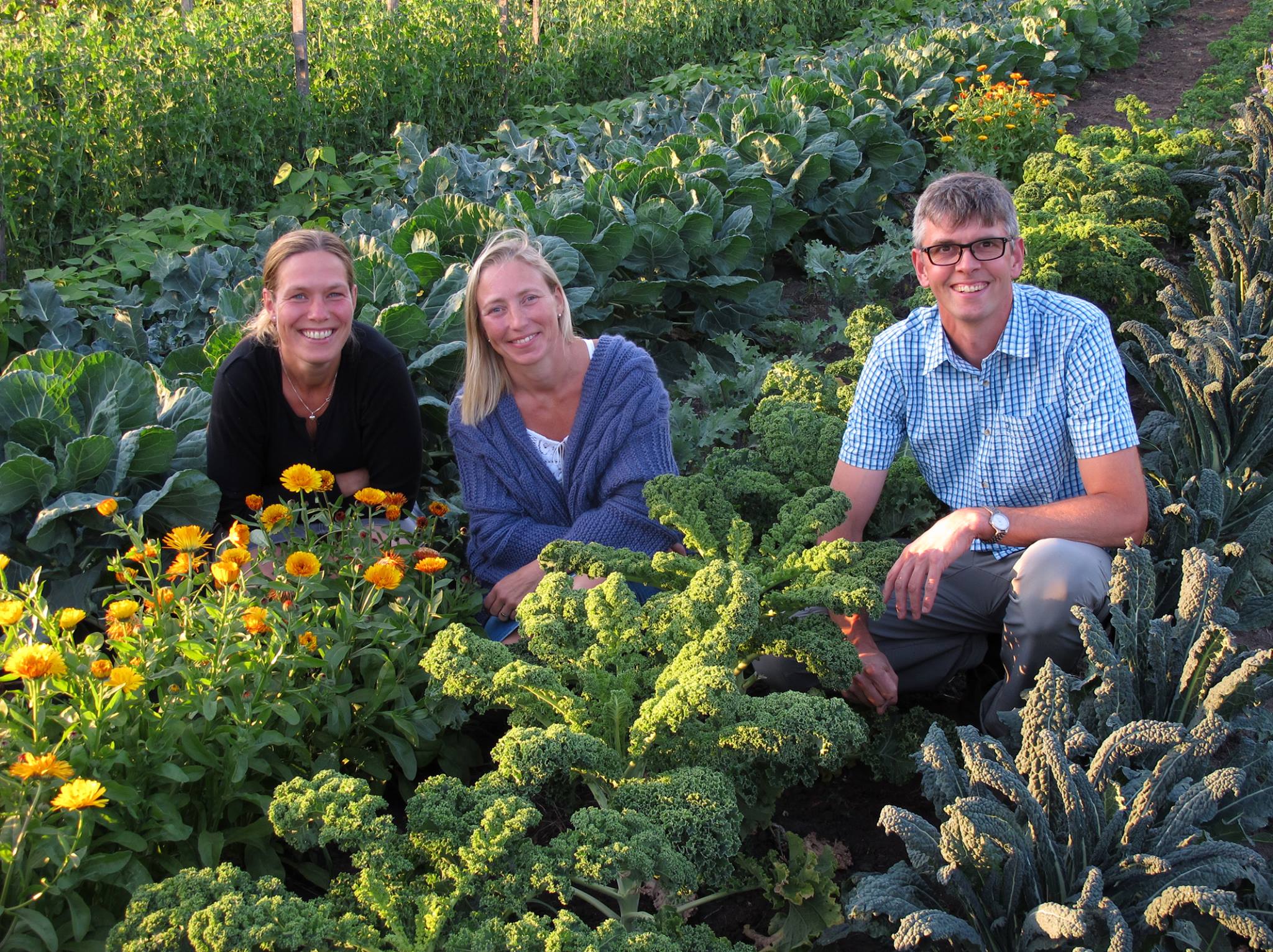
Future of farming #1 – Build topsoil with Carbon farming
Can a farm with cows, chickens and vegetable production create a positive footprint on climate and ecosystems? Yes … This is part 1 of a series on agriculture of the future, we visit some of the Nordic countries’ most innovative innovative agriculture.
We regularly share farm inspiration and have written about everything from greenhouse farming above the Arctics to social farming projects in refugee camps in Hamburg. But we feel it is now time to give an overview of the future of agriculture and what needs to be done to tackle our climate challenges and other fate issues. So lets get started! First of all, we thought of raising an example of regenerative agriculture – also known as carbon farming. Last Sunday we visited two regenerative farms with the ambition to net-store carbon dioxide from the atmosphere and build up our food soils and in this blog you will learn about the meaning of regenerative agriculture based on their business. Let’s go!
Building topsoil is the most important issue of our time!
One of our major challenges in the conventional way we produce food is that it depletes our food soils.
Over the past 40 years, development has gone so far that we have now lost 2/3 of all food land and every year we are losing agricultural land corresponding to one area in the whole of Great Britain.
The food soil contains mud or so-called organic matter (OM) which consist of 50% carbon. Sure, but how is that soil organic matter created? Well, the process that nature builds this is through the roots of plants and by growing and keeping grazing animals properly, one can thus create a net storage of carbon dioxide while creating muddy soil that holds both more water and nutrients.
Did you know that there is more carbon dioxide stored in our soils than in both the atmosphere and the biosphere? In fact, we can absorb enough of the air’s CO2 in our soils to prevent climate change!
In the following video you will get an overview of how the earth and climate issue are related and what we must do to seriously prevent global warming.
Farms that build topsoil also capture carbon dioxide
Last Sunday we were on a study trip as part of the project Pre-study Andelsjordbruk. We visited Kyrkbygård which became KRAV certified 18 years ago. But according to Jesper who runs the farm, organic is not good enough. Since this year they have been practicing plow-free so-called “regenerative” agriculture, which builds the soil content in the soil and at the same time stores carbon dioxide from the atmosphere!
You can build meter-deep soils with a soil content of 5-10% instead of today’s soils which usually at most have about 25cm deep roots with 1% soil content.
“If every farmer in the United States would practise this system, in fewer than 10 years we would sequester ALL the CARBON that’s been emitted since the beginning of the Industrial Age…”
We will upload a little video from the farms where we explain a little about what regenerative farming means. Feel free to subscribe to our youtube channel so as not to miss the video when it comes out!
Pictures from Kyrkbygård and their various activities
How does this work then? Can’t the cows actually be good for the climate?
With 31 hectares of land area at Kyrkbygård, the main production is grassland, grazed by Holistic Management with cows and chickens in egg mobile on green pastures, moved daily. With manure from the cows, a so-called “no dig” market garden was built up of 1000 sqm with 600 sqm of efficient cultivation area that can create a half-time income of six months! NO DIG, is just what it sounds like – you don’t dig or turn the soil, instead you add a deep layer of mulch like compost of manure – and in this way it becomes much less weeds. The only thing you need to do is apply enough manure or compost when you build your farm and then continuously.
In this way, we create a positive spiral where the soil automatically binds more and more carbon dioxide and builds topsoil over time.
All these activities are related, the cows graze down the grass just when it has grown to the largest, leaving 40% of its growth which is trampled down to become organic material. Their cow poop stimulate micro life and by having a large animal on a small area and then letting the soil rest long enough, in this way you can build up the soil organic matter for each year.
A pioneer: Ridgedale Farm
Last summer we visited the farm which has been a great inspiration for many regenerative farmers, namely Ridgedale farm in Värmland. On both Ridgedale and Kyrkbygård, you have both cows grazing, tree rows of 16-25 meters. This system of integrating trees and grazing is a type of “agroforestry” practice – were you have the same grass growth but can also get the benefits and yields from the trees – that can eventually provide nuts and fruits. After the cows come the egg mobiles with chickens that also eat the grass and encourage carbon to be captured and build soil. Learn more about Ridgedale’s various regenerative farming enterprises that can actually be profitable at the same time as they are building soil. Check out our interview with Richard Perkins:
Wait a minute now .. Did you say Egg-mobile? What does it mean??
Well, it’s very exciting. However, it is not about the hens having their own smart-phone, but more about the hen house that can be moved around.
Here’s how it is: Chickens are normally kept indoors today and even though the chickens are said to be “free range” they usually only have “access to outdoor areas” where it is often so crowded indoors so it is still very difficult to get out. But with an egg mobile, the chickens can be out on green pastures all summer, which saves a lot of feed and makes the eggs more nutritious (you can actually see that the eggs have more yellow yolks).
In holistic pasture planning, you move the animals so often that the animals are not on the same surface for more than 3 days, otherwise you will easily deplete the roots of the grass by grazing on the new small, thin grass leaves that emerge immediately after 3 days.
Therefore, the chicken is moved every other day approximately to always have new fresh grazing and thus the chicken house is built on wheels.
At Ridgedale, as well as Kyrkbygård, you let the chickens follow the cows – so that just as in nature they can eat the larvae that hatch in the cattle’s crap. The cows and chickens also provide fertilizer in the winter which becomes compost for vegetable cultivation and builds up its fertility. To show a little about how a chicken cellphone works, we did an interview last year at Ridgedale focusing on the chickens.
Yep, that was all for this first part of the Agriculture of the Future .. Now don’t forget to share this article with your friends so we can inspire more to start building food soil in our elongated country!
PS: We also offer cultivation land for those who want to start growing!
And for those who want to take the step to start growing with these methods, we also have the cultivation land that we match through GrowGbg. Check out www.growgbg.com/land to see if there are land areas near you. Or why not share arable land if you are sitting on a plot near the town or a larger area in the countryside. Our goal is to facilitate more regenerative cultivation and we are happy to help you find growers for your unused land.
Follow us on Facebook and Instagram and subscribe to our newsletter so you don’t miss any new updates!
See you soon!
/Jonathan
